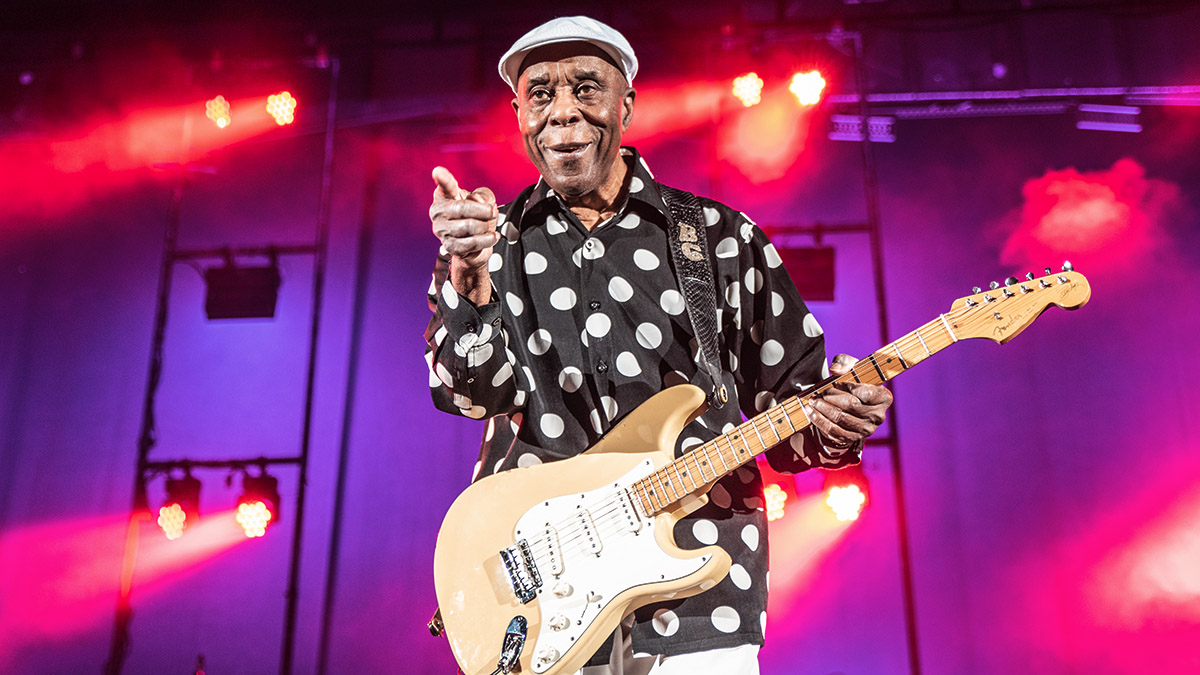Buddy Guy is one of the most influential guitar players of all time, inspiring everyone from Jimi Hendrix to John Mayer – learn the soloing style of a living guitar legend
We look at what makes the Chicago great's pentatonic playing essential learning for generations of blues guitarists

Buddy Guy is one of the most influential and important Chicago bluesmen in the history of blues, and of guitar playing in general. He’s influenced generations of players including many of the world’s most iconic names including Hendrix, Clapton, Jimmy Page, Stevie Ray Vaughan, Jeff Beck, and as up-to-date as John Mayer.
Guy was born and raised in Louisiana in the mid 1930s. By the time he hit his early 20s he was performing in local bands while holding down a day job. But Guy had his sites on bigger goals and so made the move to Chicago.
Here he fell under the influence of Muddy Waters, and in 1958 won a competition hosted by Magic Sam and Otis Rush, gaining him his first record deal. Not long after this, he signed with Cobra Records which led to even more opportunities.
Ike Turner helped Buddy make his second record, contributing rhythm guitar work and composing some of the material. From there he went from strength to strength and stepped up with a new record deal with the legendary Chess Records.
Sadly, this particular move didn’t work out too well for Buddy. He wanted to make records that captured the power and excitement of one of his shows, but the label tried to force him down a different artistic route. His way around this was to release music with Delmark Records under the pseudonym Friendly Chap. But he was able to earn money with Chess records as sideman for Muddy Waters, Howlin’ Wolf, Little Walter and other stars of the time.
Buddy is often associated with the Chicago blues style, but he has a very eclectic approach and loves to explore all expressions of the blues. This in part will have been what’s made him a success for 50 years and enabled him to maintain a busy touring schedule even to the present day. (To get Buddy’s full story from the man himself, check out our recent interview where he opens up on his retirement from the road and his 70-year career as a true blues original.)
Buddy has accumulated many awards over the years. He’s won eight Grammys throughout his career and has also been granted the Lifetime Achievement award. As well as these prestigious accolades he was inducted into rock and roll’s Hall Of Fame by no less than Eric Clapton and B.B. King.
Buddy’s playing covers a broad range of approaches. Our first study explores his tradional 1950s 12-bar major pentatonic-based approach, including some great turnaround phrases. The second example utlises more major pentatonic playing but in a much funkier R&B setting. There are lots of great licks to learn here, but make sure you play them with Buddy’s fire and passion.
Get the tone
Amp Settings: Gain 2, Bass 6, Middle 4, Treble 7, Reverb 6
Buddy is best known for playing Fender Stratocasters. His tone is aggressive and precise, most likely due to using Fender Bassman or Twin Reverb tube amps turned up extraordinarily loud, to give his tone that clear but gnarly edge. To achieve this kind of attack, a very mild overdrive or clean boost pedal can be used, alongside a touch of slapback delay or reverb.
Example 1. '50s-style blues shuffle
This study is great 12-bar shuffle with some large bends and 50s-style double-stop phrases. Approach the lines in this with a ‘minor pentatonic visualisation’ approach, but replace the b7 on the second string with the 6th interval, and focus on the major 3rd on the third string for the major pentatonic sound.
Example 2. R&B-style blues
This study builds on a thematic idea that grows and expands over the solo. Again, we’re drawing on the major pentatonic vocabulary here to outline the sounds of the chords. The key to this study is getting the rhythmic elements really locked in, so pay close attention to the note lengths to make the solo sound authentic.
Get The Pick Newsletter
All the latest guitar news, interviews, lessons, reviews, deals and more, direct to your inbox!
Phil Short is a sought-after guitarist from the UK. A stadium player, Phil is well known for his technically accomplished guitar style and has showcased his talent touring with Irish boyband Westlife. As well as touring, Phil has been a visiting lecturer at BIMM London since 2017, teaching performance, technique and improvisational skills to the next generation of guitarists. Phil is a monthly contributor for Guitar Techniques magazine, writing the blues column as well as video features on iconic rock legends.
“There are so many sounds to be discovered when you get away from using a pick”: Jared James Nichols shows you how to add “snap, crackle and pop” to your playing with banjo rolls and string snaps
Don't let chord inversions bamboozle you. It's simply the case of shuffling the notes around








![Joe Bonamassa [left] wears a deep blue suit and polka-dotted shirt and plays his green refin Strat; the late Irish blues legend Rory Gallagher [right] screams and inflicts some punishment on his heavily worn number one Stratocaster.](https://cdn.mos.cms.futurecdn.net/cw28h7UBcTVfTLs7p7eiLe.jpg)


